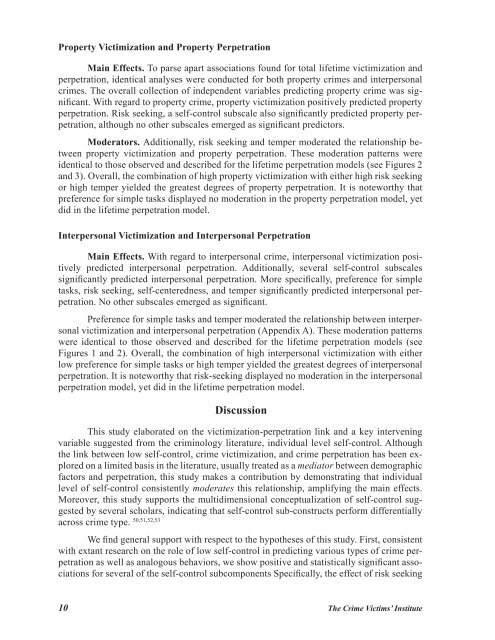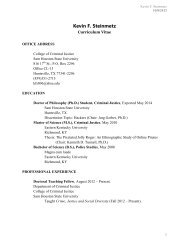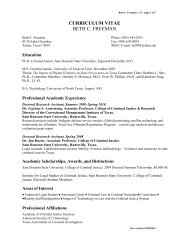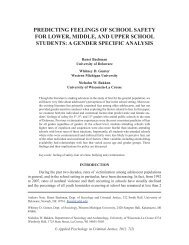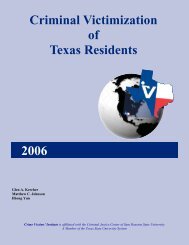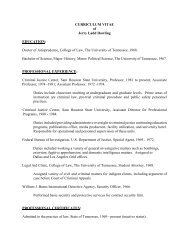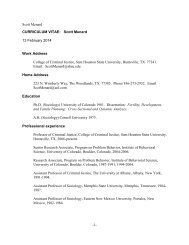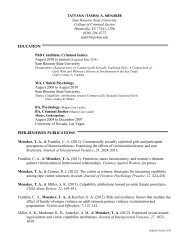Property Victimization and Property PerpetrationMain Effects. To parse apart associations found for total lifetime victimization andperpetration, identical analyses were conducted for both property crimes and interpersonalcrimes. The overall collection of independent variables predicting property crime was significant.With regard to property crime, property victimization positively predicted propertyperpetration. Risk seeking, a self-control subscale also significantly predicted property perpetration,although no other subscales emerged as significant predictors.Moderators. Additionally, risk seeking and temper moderated the relationship betweenproperty victimization and property perpetration. These moderation patterns wereidentical to those observed and described for the lifetime perpetration models (see Figures 2and 3). Overall, the combination of high property victimization with either high risk seekingor high temper yielded the greatest degrees of property perpetration. It is noteworthy thatpreference for simple tasks displayed no moderation in the property perpetration model, yetdid in the lifetime perpetration model.Interpersonal Victimization and Interpersonal PerpetrationMain Effects. With regard to interpersonal crime, interpersonal victimization positivelypredicted interpersonal perpetration. Additionally, several self-control subscalessignificantly predicted interpersonal perpetration. More specifically, preference for simpletasks, risk seeking, self-centeredness, and temper significantly predicted interpersonal perpetration.No other subscales emerged as significant.Preference for simple tasks and temper moderated the relationship between interpersonalvictimization and interpersonal perpetration (Appendix A). These moderation patternswere identical to those observed and described for the lifetime perpetration models (seeFigures 1 and 2). Overall, the combination of high interpersonal victimization with eitherlow preference for simple tasks or high temper yielded the greatest degrees of interpersonalperpetration. It is noteworthy that risk-seeking displayed no moderation in the interpersonalperpetration model, yet did in the lifetime perpetration model.DiscussionThis study elaborated on the victimization-perpetration link and a key interveningvariable suggested from the criminology literature, individual level self-control. Althoughthe link between low self-control, crime victimization, and crime perpetration has been exploredon a limited basis in the literature, usually treated as a mediator between demographicfactors and perpetration, this study makes a contribution by demonstrating that individuallevel of self-control consistently moderates this relationship, amplifying the main effects.Moreover, this study supports the multidimensional conceptualization of self-control suggestedby several scholars, indicating that self-control sub-constructs perform differentiallyacross crime type. 50,51,52,53We find general support with respect to the hypotheses of this study. First, consistentwith extant research on the role of low self-control in predicting various types of crime perpetrationas well as analogous behaviors, we show positive and statistically significant associationsfor several of the self-control subcomponents Specifically, the effect of risk seeking10The Crime <strong>Victims</strong>’ Institute
was consistently significant across all three crime perpetration models, while effects forself-centeredness and temper were significant for lifetime as well as interpersonal perpetration.The effect for simple tasks was significant for interpersonal crime perpetration. Second,we show positive and significant effects for self-reported victimization history across allthree perpetration types. This finding is consistent with research in personality psychologylinking victimization history to some types of offending behaviors. 55 Third, we demonstrateevidence for low self-control elements functioning as moderators between victimization historyand all three perpetration outcomes. Specifically, findings indicate that the effects ofsimple tasks, risk seeking, and temper moderated the relationship between victimization andlifetime perpetration. Moreover, risk seeking and temper moderated the relationship betweenvictimization and property perpetration, whereas simple tasks and temper moderated therelationship between victimization and personal crime perpetration.Implications for theory and policy are numerous. First, results extend and modifyfindings from the criminology literature 56, 57, 58 in that low self-control is shown as a moderatingfactor linking victimization and perpetration. This conceptual extension of the generaltheory of crime blends well with traditional frameworks of personality psychology that suggestan individual’s inherent personality trait constellation alleviates behavioral expressionssuch as criminal behavior. 59, 60 Second, this study supports generalizations of Gottfredsonand Hirschi’s (1990) theory by showing that low self-control elements may function differentiallyacross crime type, especially after controlling for other pertinent individual-levelpredictors (e.g., victimization history). 61 In fact, risk seeking was the only one of the sixself-control elements to show significant main effects across perpetration type, suggestingthat the remaining elements may exhibit different situational properties or may tap differentelements of personality.Results also show that individual-level self-control, determined by parental monitoringand support in childhood, interact with environmental risk factors in predicting perpetration.62 This finding has intuitive appeal for explaining interpersonal crimes such as domesticviolence and sexual abuse, in which a history of childhood victimization has been previouslyassociated with perpetration in adulthood. In these cases, there may be some practicalvalue to understanding the theoretical mechanisms that underlie the interaction of personaltraits and environmental influence. Addressing parental management and support becomesincreasingly policy-relevant when deficits may play some role in future offending. Goingbeyond the broader goal of passive “education” to a systematic study of obstacles blockingappropriate parental monitoring could be fruitful for social service providers. Also, theidentification of potential protective factors that could minimize environmental risk couldinfluence the second component of the interaction. While the precise mechanisms may varywidely according to social contexts, generally this could be accomplished by promoting astake in conformity, increasing individual bonds to the community, facilitating normativeand pro-social goal acquisition, or helping adolescents to identify and associate with nondelinquentpeers.These findings are also practically relevant in others ways. For instance, knowledgeof the interaction between self-control and environmental risk may also inform system response,such that individuals who are known victims, especially for interpersonal crimes,can be provided with referrals to agencies or clinicians for appropriate management. The evidencethat victimization history and low self-control interact to influence perpetration riskcan also be a helpful tool in case management for social workers, corrections professionals,<strong>Victims</strong> <strong>Become</strong> <strong>Perpetrators</strong> 11


